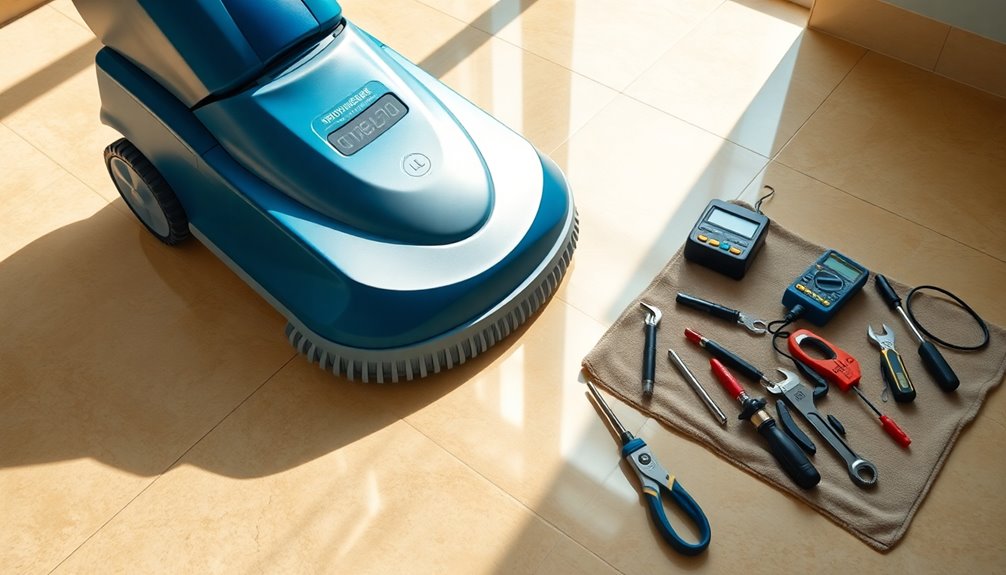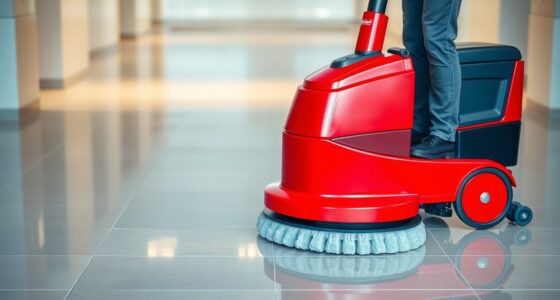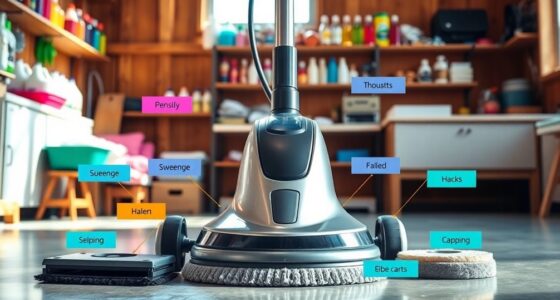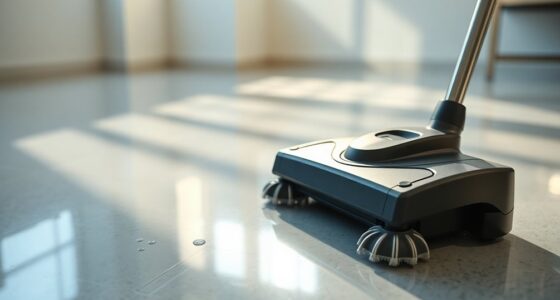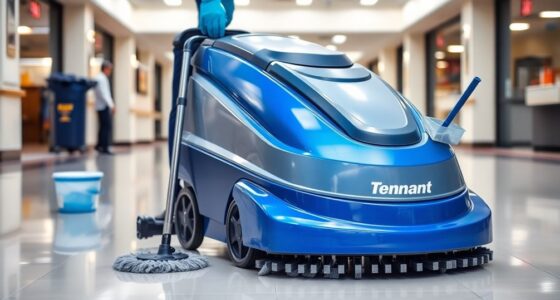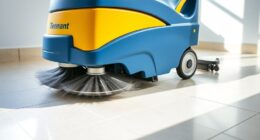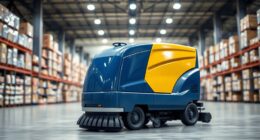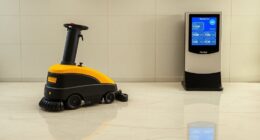When troubleshooting your floor scrubber, start by checking common issues like water pickup and scrubbing results. Ensure the vacuum system's on, inspect hoses for blockages, and replace worn pads or brushes. For brush deck problems, confirm the battery's charged and look for jams. Also, inspect tanks and solutions for clogs if you face water release issues. We'll cover more tips on keeping your scrubber in top shape, so stay tuned for the next steps!
Key Takeaways
- Always start by checking the power source and ensuring the scrubber is properly plugged in and the batteries are charged.
- For poor scrubbing results, use the right pad or brush for your floor type and inspect for wear regularly.
- If water pickup is inadequate, ensure the vacuum system is activated and inspect for blockages in hoses and squeegees.
- Address brush deck issues by checking for jams, inspecting battery levels, and consulting the manual for specifications.
- Schedule regular maintenance to clean filters and inspect components, preventing common issues and improving scrubber performance.
Common Issues With Floor Scrubbers

When you're using a floor scrubber, it's frustrating to encounter common issues that can hinder its performance. Insufficient cleaning results may arise from improper pad or brush selection, excessive pressure, or poor chemical use. Additionally, using the correct types of floor scrubbers can significantly enhance cleaning efficiency in various settings. Battery performance can decline if you don't charge them properly or allow them to deep discharge. Clogged systems, whether in hoses or tanks, can drastically impede efficiency, so regular cleaning is essential. Worn-out components like pads and squeegees need timely replacement to maintain effectiveness. Lastly, improper maintenance and neglecting regular inspections can lead to premature wear, costing you time and money. Being aware of these issues lets you take proactive steps to keep your scrubber running smoothly.
Troubleshooting Poor Water Pickup

Poor water pickup can significantly impact your floor scrubber's cleaning efficiency, so it's important to address any issues promptly.
Start by checking if the vacuum system is activated; many machines need manual activation. Inspect the vacuum hose for blockages and clear any debris. Look for cracks or tears in the hose, which may require professional repair. Ensure all connections between the hose and recovery tank are secure.
Next, examine the squeegees—if they're worn or misaligned, they won't perform effectively. Clean the squeegees regularly and replace them if needed. Additionally, ensure that the vacuum system is turned on, as this is crucial for effective water pickup.
Finally, verify that the recovery tank isn't full and that the float mechanism operates smoothly. Regular maintenance and inspections will help you avoid these problems in the future.
Addressing Poor Scrubbing Results

To achieve optimal cleaning results, it's crucial to address any issues affecting your floor scrubber's performance.
Start by ensuring you're using the correct pad or brush for the specific floor type; using the wrong one can hinder scrubbing effectiveness. Regularly inspect pads and brushes for wear—worn-out components can significantly reduce efficiency. Additionally, regular inspections and cleaning prevent ineffective water pickup, insufficient cleaning results, and reduced battery performance.
Adjust the pressure settings based on the floor type to avoid damage and ensure thorough cleaning. Make sure that your pads or brushes are compatible with both the floor and the cleaning chemicals you're using.
Finally, don't forget regular maintenance; cleaning and replacing pads and brushes as needed will extend their lifespan and improve scrubbing results.
Resolving Brush Deck Problems

Achieving optimal scrubbing results often leads to concerns about the brush deck's performance. Start by checking the battery level; a low battery can restrict features, including the brush deck.
Next, inspect for any jams or damage that might hinder its movement. If you're using the wrong type of pad or brush, it might affect performance, so refer to your manual for the correct specifications. Regular maintenance is crucial—clean the brushes and schedule routine checks to prevent mechanical issues. Additionally, ensure all operators are trained on proper use to avoid operator errors.
If problems persist, don't hesitate to consult a technician or utilize diagnostic tools for advanced troubleshooting. Keeping spare parts handy can also help you tackle issues swiftly. Remember, poor scrubbing results may also occur due to incorrect pad pressure settings, so adjust accordingly based on your floor type.
Fixing Water Release Issues
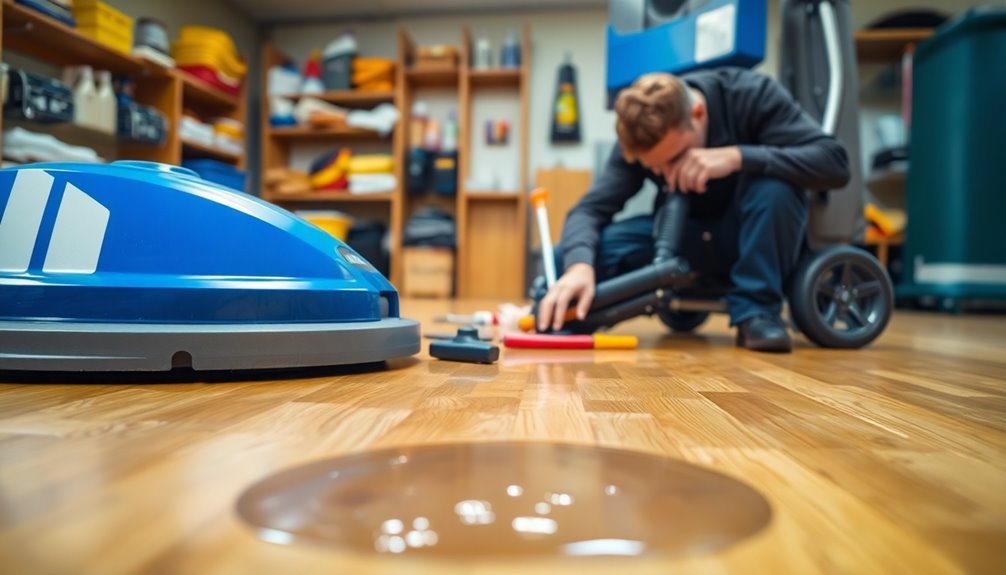
When you're facing water release issues with your floor scrubber, it's essential to pinpoint the cause quickly to maintain optimal performance.
Start by checking the water tank; make sure it's filled to the recommended level. Next, inspect the solution filter for clogs and clean or replace it as needed.
Look for debris in the solenoid and ensure the water flow controls are set correctly. Verify pump functionality by checking for power, and inspect hoses for blockages or kinks. Additionally, check the pump and solenoid for power to ensure they are functioning properly.
Don't forget to check tank valves and the water flow switch.
For future prevention, schedule regular maintenance, clean filters, and inspect hoses. Proper training for operators can also help avoid these issues down the line.
Troubleshooting Power Issues
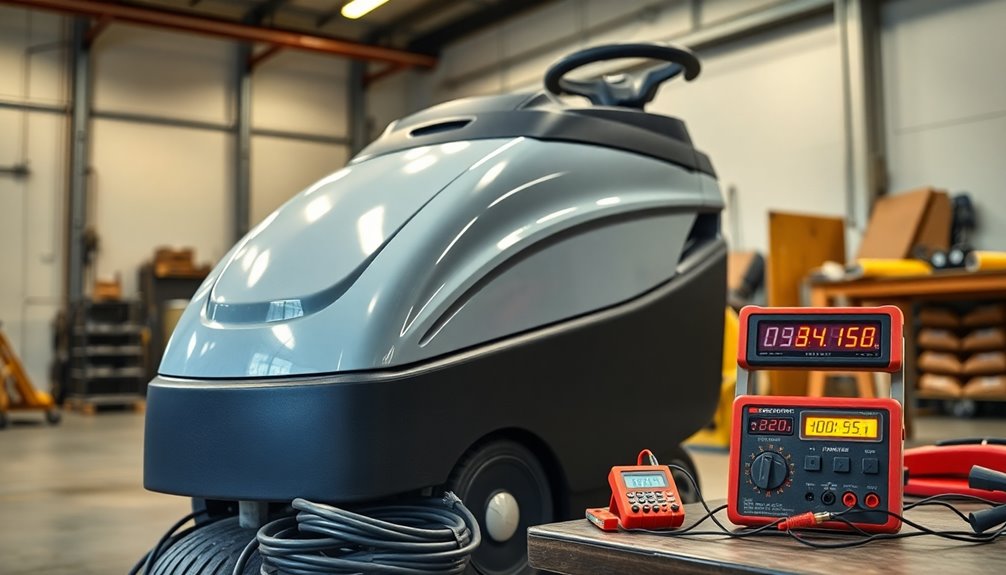
Power issues can be frustrating, especially when they disrupt your cleaning routine. Start by checking the power source; make sure your scrubber's plugged into a working outlet and inspect the power cord for any damage.
Test the outlet with another device to rule out faults and confirm the circuit breaker hasn't tripped—reset it if needed.
Next, examine the batteries. Ensure they're fully charged and connections are secure. Maintaining battery health is crucial, especially for wet cell types.
Don't forget to check for resettable fuses—reset any that have tripped.
Lastly, ensure the main switch is on, and emergency stops aren't activated. If you still face issues, consult an authorized technician for further assistance.
Frequently Asked Questions
How Often Should I Maintain My Floor Scrubber?
You should maintain your floor scrubber regularly to ensure optimal performance.
Conduct daily checks and clean the brushes and pads to keep everything running smoothly.
Weekly, give it a thorough cleaning, and monthly, perform detailed inspections to catch hidden issues.
Every quarter, do a deep clean, and don't forget an annual overhaul for longevity.
Following this schedule will help you avoid unexpected problems and extend the lifespan of your machine.
What Type of Cleaning Solution Is Best for My Floor?
Imagine a shimmering lake reflecting the sun; that's how your floor should look after cleaning.
To choose the best cleaning solution, consider your floor type. For hardwood, use a gentle cleaner; for tile, a stronger option works wonders. Check compatibility to avoid damage.
Eco-friendly cleaners are great if you have kids or pets. Lastly, think about whether you want concentrated solutions for cost savings or ready-to-use for convenience.
Your floors will thank you!
Can I Use My Floor Scrubber on All Floor Types?
You can't use your floor scrubber on all floor types. It works well on vinyl, tile, concrete, and hardwood, but you should avoid using it on carpeting or unfinished wood.
Each surface requires different brushes and cleaning solutions for optimal results. Assess your floor type carefully to choose the right scrubber and ensure you're using compatible cleaning agents.
This way, you'll maintain your floors without causing any damage.
How Do I Store My Floor Scrubber Properly?
To store your floor scrubber properly, keep it in a cool, dry place, away from heat sources and potential flooding.
Drain and rinse the tanks, leaving lids open for airflow. Charge the battery before storage and maintain it periodically.
Ensure connections are tight and check for corrosion. Inspect bristle lengths and cleaning pads regularly, replacing them if necessary.
Finally, clean the squeegee assemblies and debris tray to prevent mold and clogs.
What Are the Signs That I Need to Replace My Floor Scrubber?
You'll know it's time to replace your floor scrubber when you notice visible wear on pads or brushes, like thinning or frayed edges.
If your scrubber leaves dirt behind after multiple passes or takes longer to clean, that's a red flag.
Unusual noises during operation and uneven cleaning patterns also indicate malfunctioning parts.
Regularly inspecting these components ensures your scrubber operates efficiently, so don't ignore these signs!
Conclusion
In conclusion, mastering your floor scrubber's troubleshooting can save you time and money. Did you know that regular maintenance can boost your scrubber's efficiency by up to 30%? By addressing common issues like poor water pickup and brush deck problems promptly, you keep your machine running smoothly and extend its lifespan. So, don't wait for problems to escalate; take charge of your floor scrubber today and keep your floors looking their best!
